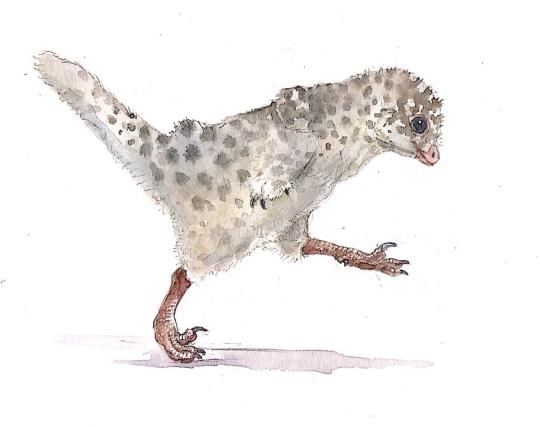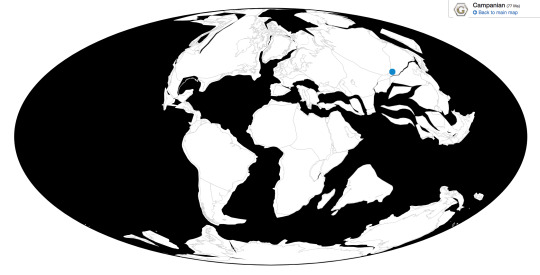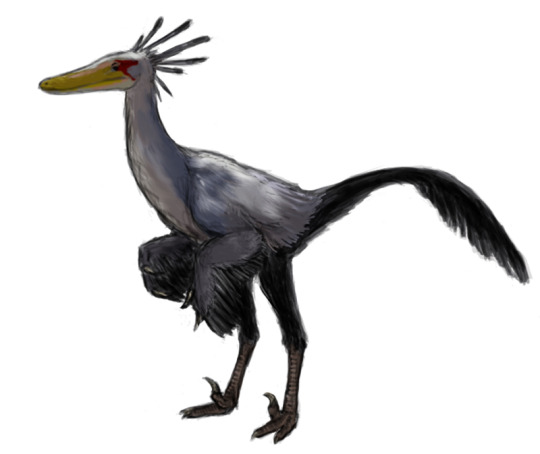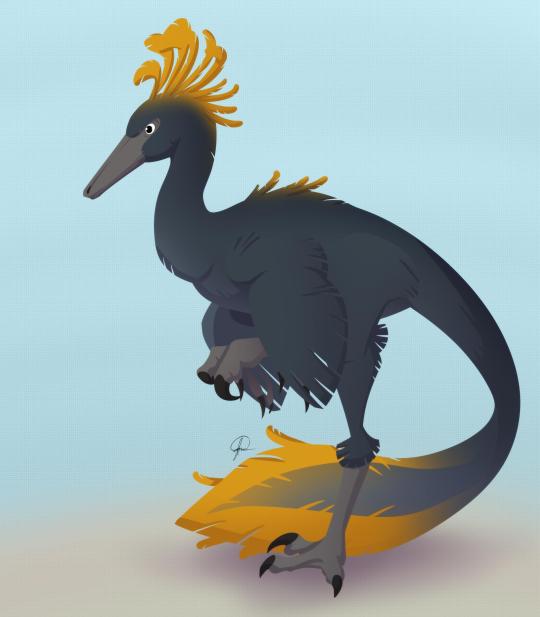#slavoia
Photo

Slavoia darevskii was a lizard that lived in what is now Mongolia and Kazakhstan during the Late Cretaceous, about 85-70 million years ago.
Around 12cm long ~(4.75"), it had a compact skull, small eyes, a short neck, shovel-like hands, an elongated body and slightly reduced hind limbs – all features that indicate it was a burrowing animal, digging tunnels and feeding on underground invertebrates.
Its exact relationships are uncertain, but recent studies have suggested it was an early amphisbaenian, representing a point in the group's evolution before the full loss of their legs and the development of their extremely long worm-like shape.
———
Nix Illustration | Tumblr | Twitter | Patreon
#science illustration#paleontology#paleoart#palaeoblr#slavoia#amphisbaenia#worm lizard#lacertoidea#squamata#lizard#lepidosauria#reptile#art
224 notes
·
View notes
Text
Byronosaurus jaffei

By Ripley Cook
Etymology: Byron’s Reptile
First Described By: Norell, Makovicky, & Clark, 2000
Classification: Dinosauromorpha, Dinosauriformes, Dracohors, Dinosauria, Saurischia, Eusaurischia, Theropoda, Neotheropoda, Averostra, Tetanurae, Orionides, Avetheropoda, Coelurosauria, Tyrannoraptora, Maniraptoriformes, Maniraptora, Pennaraptora, Paraves, Eumaniraptora, Troodontidae, Troodontinae
Status: Extinct
Time and Place: Between 78 and 75 million years ago, in the Campanian of the Late Cretaceous


Byronosaurus is known from the Ukhaa Tolgod of the Djadokhta Formation in Mongolia

Physical Description: Byronosaurus was a Troodontid, a type of slender almost-bird with the same sickle-shaped claws as the famous Raptors, but much smaller and built more for trapping food than strategic stabbing. Like other members of the group, Byronosaurus was fairly small, slender, with large wings and skinny legs 0 it only reached about 1.5 meters in length, and 50 centimeters in height, weighing only 4 kilograms. It had a long, narrow snout attached to a decently sized neck. Its tail was also long, ending in a tail fan. Like other Troodontids, it had very closely-spaced together teeth, and a lot of them to boot. These were non-serrated teeth, which is weird for a Troodontid. It was also extremely intelligent - Troodontids had some of the larger brains for their body size of dinosaurs at the time. It would have been very fluffy indeed. We also have babies of Byronosaurus, which were either just hatched or about to hatch; they had big eyes, like most babies, and in general “cute” features.

By Michael B. H., CC BY-SA 3.0
Diet: Byronosaurus would have fed on a variety of small animals such as mammals, lizards, and baby dinosaurs.
Behavior: Byronosaurus would have been a fairly active and skittish animal, attempting to dodge predators and larger dinosaurs while still finding food. It probably would have ducked in between and around shrubs and other brittle desert plants, looking for its prey. It then could have darted into the brush, grabbed the food, and pinned it down using its feet. It probably didn’t engage much in raptor-prey-restraint flapping, though it could have if it needed to; though it likely did engage in wing-assisted-inclined-running, using powerful flaps and its light weight to run up vertical surfaces such as cliffs. It probably used its wings and tail fan for display, fluffing them out and extending them to talk to other Byronosaurus. They also would have looked distinctly different from other feathery dinosaurs in the area, using color and patterns to stand out amongst their cousins. As a desert animal, it also probably would have tried to conserve its energy wherever it could, hiding in places of shade. Byronosaurus took care of its young, and its possible that they did so in family groups.

By José Carlos Cortés
Ecosystem: The Djadochta Formation was an arid desert, with red sand and dirt for miles around. This red coloration of the ground gave it the famous name “Flaming Cliffs,” and probably would have made most dinosaurs in the area actually quite red themselves, in order to blend in. Freshwater here was present - enough to have freshwater-adapted animals - but rare, only taking the form of oases and arroyos. No plant fossils are known, but they would have likely been dry shrubs and other arid-adapted plants. Here, Byronosaurus shared its environment with an innumerable variety of dinosaurs - ankylosaurs like Pinacosaurus, ceratopsians like Protoceratops, Alvarezsaurs like Kol and Shuvuuia, Oviraptorosaurs like Citipati and Khaan, Dromaeosaurs like Halszkaraptor and Velociraptor and Acheroraptor, other Troodontids like Almas, Opposite Birds like Gobipteryx, and True Birds like Apsaravis. Non-dinosaurs were present in droves too - there were Crocodylomorphs like Shamosuchus and Zaraasuchus, lizards aplenty from Slavoia to Isodontosaurus to Parmeosaurus to Mimeosaurus to Adamisaurus, turtles like Zangerlia, and a lot of small mammals like Deltatheridium and Maelestes and Zalambdalestes and Bulganbaatar and Kryptobaatar. Ultimately, lizards grew like weeds in the Djadochta, and would have been the primary source of food for Byronosaurus. Interesting enough, Byronosaurus may have had its eggs stolen and eaten by - or it parasitized the nests of - Citipati.
Other: Byronosaurus is one of many theropods known from the Djadokhta Formation, a place that is weirdly theropod heavy (and, at that, fluffy theropod heavy). It is known from multiple specimens, and is closely related to the Troodontines of North America.
~ By Meig Dickson
Sources under the Cut
Bever, G.S. and Norell, M.A. (2009). "The perinate skull of Byronosaurus (Troodontidae) with observations on the cranial ontogeny of paravian theropods." American Museum Novitates, 3657: 51.
Cau, A.; Beyrand, V.; Voeten, D.; Fernandez, V.; Tafforeau, P.; Stein, K.; Barsbold, R.; Tsogtbaatar, K.; Currie, P.; Godefroit, P. (2017). "Synchrotron scanning reveals amphibious ecomorphology in a new clade of bird-like dinosaurs". Nature.
Chinzorig Tsogtbaatar; Yoshitsugu Kobayashi; Tsogtbaatar Khishigjav; Philip J. Currie; Mahito Watabe; Barsbold Rinchen (2017). "First Ornithomimid (Theropoda, Ornithomimosauria) from the Upper Cretaceous Djadokhta Formation of Tögrögiin Shiree, Mongolia". Scientific Reports. 7: Article number 5835.
Clarke, Julia A., Norell, Mark A. (2002). "The morphology and phylogenetic position of Apsaravis ukhaana from the Late Cretaceous of Mongolia". American Museum Novitates, No. 3387, American Museum of Natural History, New York, NY.
Godefroit, Pascal; Currie, Philip J.; Li, Hong; Shang, Chang Yong; Dong, Zhi-ming (2008). "A new species of Velociraptor (Dinosauria: Dromaeosauridae) from the Upper Cretaceous of northern China". Journal of Vertebrate Paleontology. 28 (2): 432–438.
Hartman, S., M. Mortimer, W. R. Wahl, D. R. Lomax, J. Lippincott, D. M. Lovelace. 2019. A new paravian dinosaur from the Late Jurassic of North America supports a late acquisition of avian flight. PeerJ: e7247.
Junchang Lü; Li Xu; Yongqing Liu; Xingliao Zhang; Songhai Jia & Qiang Ji (2010). "A new troodontid (Theropoda: Troodontidae) from the Late Cretaceous of central China, and the radiation of Asian troodontids". Acta Palaeontologica Polonica. 55 (3): 381–388.
Ksepka, Daniel T.; Norell, Mark A. (2004). "Ornithomimosauria cranial material from Ukhaa Tolgod (Omnogov, Mongolia)". American Museum Novitates. 3448: 1–4.
Longrich, Nicholas R.; Philip J. Currie; Dong Zhi-Ming (2010). "A new oviraptorid (Dinosauria: Theropoda) from the Upper Cretaceous of Bayan Mandahu, Inner Mongolia". Palaeontology. 53 (5): 945–960.
Makovicky, P.J.; Norell, M.A.; Clark, J.M.; Rowe, T.E. (2003). "Osteology and relationships of Byronosaurus jaffei (Theropoda: Troodontidae)". American Museum Novitates. 3402: 1–32.
Mackovicky, Peter J.; Norell, Mark A. (2004). "Troodontidae". In Weishampel, David B.; Dodson, Peter; Osmólska, Halszka (eds.). The Dinosauria (2nd ed.). Berkeley: University of California Press. pp. 184–195.
Montague, R. (2006). "Estimates of body size and geological time of origin for 612 dinosaur genera (Saurischia, Ornithischia)". Florida Scientist. 69 (4): 243–257.
Norell, Mark A.; Clark, James M.; Dashzeveg, Demberelyin; Barsbold, Rhinchen; Chiappe, Luis M.; Davidson, Amy R.; McKenna, Malcolm C.; Perle, Altangerel; Novacek, Michael J. (November 4, 1994). "A theropod dinosaur embryo and the affinities of the Flaming Cliffs dinosaur eggs". Science. 266 (5186): 779–782.
Norell, M.A.; Clark, J.M.; Turner, A.H.; Makovicky, P.J.; Barsbold, R.; Rowe, T. (2006). "A new dromaeosaurid theropod from Ukhaa Tolgod (Omnogov, Mongolia)". American Museum Novitates. 3545: 1–51.
Norell, M.A., Makovicky, P.J. & Clark, J.M., 2000, "A new troodontid theropod from Ukhaa Tolgod, Mongolia", Journal of Vertebrate Paleontology 20(1): 7-11
Novacek, M.J., Norell, M.A, McKenna, M.C. and Clark, J.M, 1994, "Fossils of the Flaming Cliffs", Scientific American 271(6), 60-69
Pei, R.; Norell, M.A.; Barta, D.E; Bever, G.S.; Pittman, M.; Xu, Xing (2017). "Osteology of a New Late Cretaceous Troodontid Specimen from Ukhaa Tolgod, Ömnögovi Aimag, Mongolia". American Museum Novitates (3889): 1–47
Tsuihiji, T.; Barsbold, R.; Watabe, M.; Tsogtbaatar, K.; Chinzorig, T.; Fujiyama, Y.; Suzuki, S. (2014). "An exquisitely preserved troodontid theropod with new information on the palatal structure from the Upper Cretaceous of Mongolia". Naturwissenschaften. 101: 131–142.
Turner, A.H.; Nesbitt, S.J.; Norell, M.A. (2009). "A Large Alvarezsaurid from the Cretaceous of Mongolia". American Museum Novitates. 3648: 1–14.
Varricchio, D.J.; Barta, D.E. (2015). "Revisiting Sabath's "Larger Avian Eggs" from the Gobi Cretaceous". Acta Palaeontologica Polonica. 60 (1): 11–25.
Weishampel, David B.; Dodson, Peter; and Osmólska, Halszka (eds.): The Dinosauria, 2nd, Berkeley: University of California Press. 861 pp.
#Byronosaurus jaffei#Byronosaurus#Troodontid#Dinosaur#Bird#Birds#Dinosaurs#Birblr#Palaeoblr#Prehistoric Life#Paleontology#Prehistory#Maniraptoran#Feathered Dinosaurs#Cretaceous#Eurasia#Theropod Thursday#Carnivore#Factfile#biology#a dinosaur a day#a-dinosaur-a-day#dinosaur of the day#dinosaur-of-the-day#science#nature
207 notes
·
View notes
Text
Magia cărţii, trăită din plin la Târgul Gaudeamus Radio România din Oradea
(13 mai 2019)
Cea de a şasea ediţie orădeană a Caravanei Gaudeamus Radio România s-a încheiat duminică după-amiază, în prezenţa unui public numeros. Oferta atractivă de la standurile celor peste 60 de participanţi, care a inclus cele mai recente apariţii editoriale, jocuri educative şi muzică, preţurile accesibile, vremea frumoasă şi, nu în ultimul rând, notorietatea evenimentului, i-au adus pe orădeni în inima oraşului, în Piaţa Unirii, la o adevărată sărbătoare a cărţii. Peste 19.000 de vizitatori, o anvergură record a evenimentului – 550 mp, 50 de standuri, şi atmosfera inconfundabilă, au transformat Oradea, timp de cinci zile, într-o veritabilă cetate a cărţii. Evenimentul a avut loc în perioada 8 – 12 mai şi a fost organizat de Radio România, Primăria Municipiului Oradea şi Asociaţia pentru Promovarea Turismului din Oradea şi Regiune, într-o formulă partenerială unică pentru Caravana Gaudeamus, proiect pe care Radio România îl derulează la nivel naţional din anul 2000.
Preşedintele de onoare al ediţiei a fost profesorul şi poetul Lucian Scurtu.
Premiile Târgului Gaudeamus Radio România Oradea 2019, decernate duminică, 12 mai, participanţilor şi jurnaliştilor, au fost atribuite exclusiv prin votul publicului:
- Trofeele Gaudeamus, acordate editurilor, au revenit Grupului Editorial ART (locul 1), Editurii Humanitas (locul 2) şi Editurii Niculescu (locul 3);
- Cea mai râvnită carte a ediţiei (şi una dintre cel mai bine vândute), a fost, pentru al treilea an consecutiv, seria Harry Potter de J.K. Rowling, publicată de Editura Arthur – Grupul Editorial ART, semn că magia cărţii se trăieşte din plin la Oradea de către cei mai tineri dintre cititori;
- Trofeele Presei, pentru secţiunile publicaţii print, online şi radio au revenit săptămânalului Bihoreanul, website-ului www.bihon.ro şi postului de radio Vocea Evangheliei, cel mai frecvent menţionate de către vizitatori drept surse de informaţii despre această ediţie a târgului. Premiile pentru jurnalişti au fost acordate de către Editura Casa Radio şi getmusic.ro.
- Premiul Miss Lectura, acordat celei mai frumoase vizitatoare, de către InfoTouch Systems şi CEWE, a fost primit de Carmen Porumb.
Proiecte Radio România Gaudeamus derulate cu prilejul acestei ediţii:
- Volumele donate pentru proiectul Cărţile se întorc acasă au revenit în acest an bibliotecii comunale din localitatea bihoreană Pocola.
- Cei patru Invitaţi de nota 10 ai Târgului Gaudeamus Oradea 2019 - Alexandru Slavoia, Kurucz Csenge Dorottya, Istvan Zsuzsanna şi Arva Norbert Akos, au fost premiaţi sâmbătă, 11 mai, de către Radio România şi InfoTouch Systems.
- Tombola Gaudeamus, derulată pe baza buletinelor de Vot al Publicului, le-a adus participanţilor peste 20 de premii, constând în echipamente şi accesorii multimedia oferite de Radio România şi InfoTouch Systems, vouchere pentru produse Emex şi vouchere pentru cadouri personalizate CEWE.
Sponsori şi parteneri: InfoTouch Systems, Emex, CEWE, Clima Service SRL şi Spring Harghita. Parteneri media: Bihoreanul, InfoOradea.ro şi Agenţia de presă Rador.
Următoarea etapă a Caravanei Gaudeamus Radio România va avea loc în Piaţa Victoriei din Timişoara, în perioada 22 – 26 mai. Persoană de contact: Connie Chifor (tel. 0745.109.649, e-mail [email protected]).
Serviciul Comunicare şi Relaţii Publice
Adăugat de Luciana Gingăraşu

0 notes